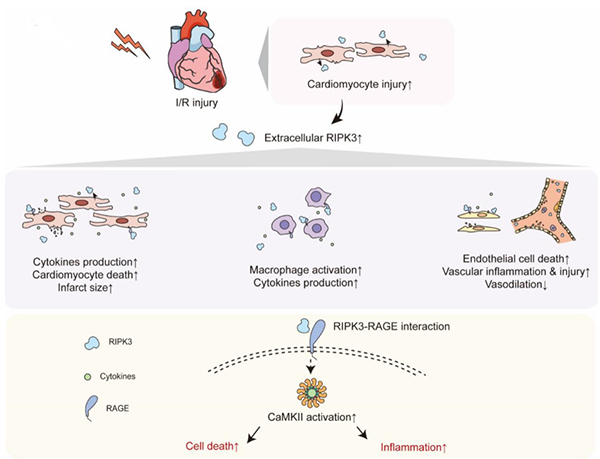

Extracellular RIPK3 aggravates cardiac ischemia/reperfusion injury through the RAGE CaMKII pathway
With the support of National Natural Science Foundation projects (approval
numbers: 82325004, 92168114, 82300286, 92168113, 82370458, 82270405),
researchers Zhang Yan and Dong Erdan from Peking University, together with the
team of Professor Zhang Shuyang and Associate Researcher Hu Xiaomin from Peking
Union Medical College Hospital, have made progress in the study of cardiac
ischemia/reperfusion injury. The research findings, titled "Extracellular RIPK3
acts as a damage associated molecular pattern to exacerbate cardiac
ischemia/reperfusion injury," were published in the journal Circulation on
November 26, 2024. Paper link:
https://www.ahajournals.org/doi/abs/10.1161/CIRCULATIONAHA.123.068595 .
Ischemia/reperfusion (I/R) injury is an important target for the treatment
of ischemic heart disease, and there is currently no effective treatment method
to reduce heart I/R injury. Damage associated molecular patterns (DAMPs) are
endogenous molecules released by cells after injury, which can exacerbate tissue
inflammation and damage. Receptor interacting protein kinase 3 (RIPK3) is an
endogenous mediator of cell necrosis and inflammation, which can be detected in
peripheral blood and serves as a biomarker for various diseases. However, it is
still unknown whether extracellular RIPK3 plays a biological role in cardiac I/R
injury.
This study found that in acute myocardial infarction (AMI) patients
undergoing percutaneous coronary intervention (PCI) surgery, plasma RIPK3
concentration was positively correlated with the occurrence of major adverse
cardiovascular events (MACE) in the short term (3 months) and long term (5
years), suggesting that RIPK3 is an important biomarker for risk stratification.
In cultured cells and in vivo mouse models, recombinant RIPK3 protein, as a
novel DAMP, acts on myocardial cells, inflammatory cells, and endothelial cells,
causing cell damage, inflammatory response, and functional disorders, thereby
participating in the occurrence of myocardial I/R injury. By targeting the
extracellular RIPK3 or its downstream receptor of advanced glycation end
products (RAGE) - calcium/calmodulin dependent kinase II (CaMKII) signaling
pathway, it is expected to provide new strategies for the prevention and
treatment of myocardial I/R injury and related complications (Figure).
This study revealed a positive correlation between plasma RIPK3
concentration and the risk of major adverse cardiovascular events in AMI
patients after PCI treatment, providing a new biomarker for risk stratification
in AMI patients and a potential therapeutic target for clinical treatment of
cardiac I/R injury.